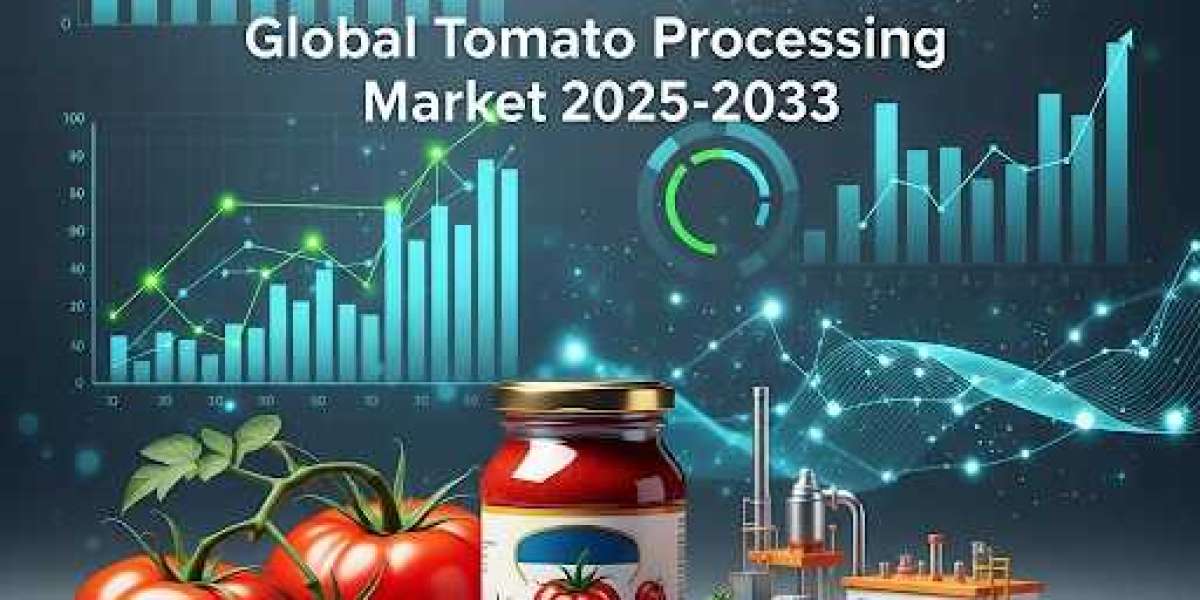MARKET OVERVIEW:
The global tomato processing market reached 48.5 million tons in 2024 and is set to climb to 64.6 million tons by 2033 (CAGR 3.21%, 2025–2033). Growth is fueled by rising consumption of sauces, pastes, ketchup, and juices, farm-to-table and organic trends, and steady RD that improves shelf life, nutrition, and flavor diversity—making processed tomato products convenient, consistent, and available year-round.
STUDY ASSUMPTION YEARS:
- BASE YEAR: 2024
- HISTORICAL YEAR: 2019–2024
- FORECAST YEAR: 2025–2033
TOMATO PROCESSING MARKET KEY TAKEAWAYS:
- Market volume: 48.5 million tons (2024); forecast 64.6 million tons (2033) at 3.21% CAGR (2025–2033).
- Sauces led by product type, supported by convenience cooking and global cuisine adoption.
- Retail market is the dominant distribution channel, strengthened by e-commerce growth and modern trade presence.
- Europe holds the largest regional share, underpinned by mature processing capacity and strong demand across cuisines.
- Health positioning (lycopene, vitamins) and clean label/organic preferences are lifting premium processed formats.
- Technology upgrades in sorting, packaging, and shelf-life extension enhance yields and reduce waste.
MARKET GROWTH FACTORS:
1) Consumer convenience and evolving food culture
Life can get hectic, and with the rise of at-home cooking, the demand for ready-to-use tomato products like sauces, pastes, ketchup, and juices is stronger than ever. As cuisines from around the world become more popular, tomato-based ingredients have found their way into Italian, Mexican, Indian, and fusion dishes, making them a staple in both home kitchens and restaurants. The retail sector is thriving, especially with the shift to online grocery shopping, which makes these products more accessible and visible, encouraging people to try them and come back for more. On top of that, health-conscious consumers are drawn to the benefits of lycopene, vitamins A and C, and cleaner labels, which support the trend toward premium products. All these factors contribute to a steady increase in tomato consumption, solidifying their status as a kitchen essential and a key ingredient for quick, delicious meals around the globe.
2) Technological advancements across processing and packaging
Thanks to rapid advancements in optical sorting, grading, and automated handling, waste is minimized, and the quality of yields is improved. Modern heat treatment and pasteurization methods ensure that products are safe while keeping their taste and nutrients intact. Plus, innovative packaging techniques like vacuum sealing and aseptic lines help extend shelf life and broaden distribution. These enhancements lead to consistent quality for retailers and foodservice providers, reducing returns and building trust in branded processed tomato products. Producers enjoy higher throughput and cost efficiencies, allowing them to offer competitive prices and invest in product innovation, such as new flavor options and reduced sodium or sugar. This creates a positive feedback loop: technology boosts profit margins and reliability, which in turn encourages wider adoption across various channels and regions.
3) Product leadership and sustainability-aligned investments
Category leaders are really stepping up their game by investing in research and development focused on flavor, stability, and nutrition, all while making sure their products meet clean-label and organic standards. They're making smart investments, like funding for climate initiatives and improving efficiency at processing plants, which helps them use resources better and reduce emissions. At the same time, they're homing in on growth categories through strategic portfolio moves and partnerships. In Europe, regional leaders are taking advantage of their solid infrastructure and high-quality standards, ensuring reliable supply on a large scale. As companies branch out with new distribution deals and enter new markets, they're boosting visibility and availability. All these actions—like enhancing plant efficiency, refining asset strategies, and forming targeted collaborations—are building market confidence and paving the way for sustained growth over the long haul.
Request for a sample copy of this report: https://www.imarcgroup.com/tomato-processing-plant/requestsample
MARKET SEGMENTATION:
Breakup by Product Type:
- Sauces
- Food Services Market: Bulk and menu-ready tomato sauces for restaurants and institutions, prioritizing consistency, speed, and cost-effective scaling.
- Home Users: Retail jars/pouches tailored for everyday cooking, offering convenience, varied flavors, and pantry-friendly formats.
- Paste
- Food Services Market: Concentrated bases for high-volume kitchens, enabling flavor depth and efficient inventory management.
- Home Users: Tubes/cans for home cooking, delivering richness and longer shelf life in compact packs.
- Canned Tomatoes
- Food Services Market: Diced/whole formats for standardized recipes, ensuring year-round supply and texture control.
- Home Users: Pantry staples for sauces, stews, and bakes, prized for reliability and ease of storage.
- Ketchup
- Food Services Market: Dispensers and bulk packs optimized for QSRs and cafeterias, ensuring throughput and minimal waste.
- Home Users: Table-friendly bottles catering to families with taste, squeeze convenience, and stability.
- Juice
- Food Services Market: Beverage and culinary base for bars, airlines, and catering, offering consistent flavor notes.
- Home Users: Packaged juices emphasizing nutrition, breakfast usage, and refreshing profiles.
- Others
- Food Services Market: Specialty derivatives (purees, concentrates) tailored to chef applications and seasonal menus.
- Home Users: Niche products meeting specific recipes and flavor preferences with compact, versatile packs.
Breakup by Distribution Channel:
- Business to Business: Direct supply to manufacturers, HORECA, and institutional buyers requiring bulk, consistent specifications, and logistics support.
- Retail Market:
- Supermarkets/Hypermarkets: Wide assortments and promotions driving high household penetration.
- Specialty Stores: Premium and organic ranges targeting discerning cooks.
- Convenience Stores: On-the-go formats and top-selling basics for quick top-ups.
- Online: E-commerce baskets, subscriptions, and long-tail variety with doorstep delivery.
- Others: Additional retail formats complementing local availability and impulse buys.
Breakup by Region:
- North America (United States, Canada)
- Asia Pacific (China, Japan, India, South Korea, Australia, Indonesia, Others)
- Europe (Germany, France, United Kingdom, Italy, Spain, Russia, Others)
- Latin America (Brazil, Mexico, Others)
- Middle East and Africa
REGIONAL INSIGHTS:
Europe is at the forefront of the global tomato processing market, thanks to its established processing capabilities, strict quality standards, and a strong appetite for tomatoes across various cuisines. The robust retail and foodservice networks, along with well-oiled supply chains and innovative products, keep demand steady in Europe while also allowing for significant exports and premium offerings.
RECENT DEVELOPMENTS NEWS:
There are some noteworthy moves towards climate-smart practices and reshaping portfolios. For instance, Pacific Coast Producers recently secured state funding in May 2023 to reduce emissions and enhance efficiency at its Woodland processing plant, highlighting a commitment to sustainability and productivity. Olam International made a strategic shift in February 2022 by selling off a 15-acre portion of its tomato processing facility but kept nearby facilities for complementary products. Earlier, in March 2020, NEC and Kagome teamed up to implement AI-driven farm management support, showcasing a push for digital optimization from the field all the way to the factory. Together, these initiatives emphasize the importance of efficiency, focus, and integrating technology into operations.
KEY PLAYERS:
- Conagra Foodservice, Inc
- CONESA Group
- Del Monte Foods, Inc
- Ingomar
- J.G. Boswell Tomato Company
- Kagome Co., Ltd.
- Stanislaus Food Products
- The Campbell's Company
- The Kraft Heinz Company
- The Morning Star Company
Ask Analyst for Customization: https://www.imarcgroup.com/request?type=reportid=637flag=C
If you require any specific information that is not covered currently within the scope of the report, we will provide the same as a part of the customization.
About Us:
IMARC Group is a global management consulting firm that helps the world’s most ambitious changemakers to create a lasting impact. The company provides a comprehensive suite of market entry and expansion services. IMARC offerings include a thorough market assessment, feasibility studies, company incorporation assistance, factory setup support, regulatory approvals and licensing navigation, branding, marketing and sales strategies, competitive landscape, and benchmarking analyses, pricing and cost research, and procurement research.
Contact Us:
IMARC Group
134 N 4th St. Brooklyn, NY 11249, USA
Email: sales@imarcgroup.com
Tel No: (+1-201971-6302)



